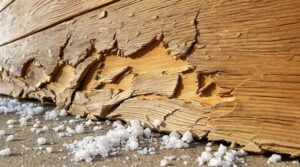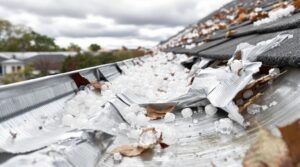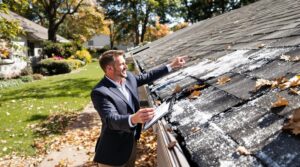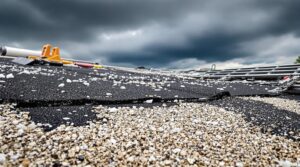Is your siding looking like it just went 12 rounds with Mother Nature's golf balls? Let's talk hail damage – it's more than just a cosmetic headache for homeowners!
Think of your home's siding as its protective armor, and when hail strikes, it leaves behind telltale battle scars. You'll spot dimples in metal siding that look like someone played percussion with your house, spider-web cracks sneaking across vinyl panels, or paint that's suddenly sporting the "distressed" look nobody asked for.
Don't let these warning signs slide! Getting your siding fixed isn't just about keeping up appearances – it's about protecting your biggest investment. While minor patches might set you back $200, more extensive repairs can climb up to $1,000, depending on the damage's severity.
What about your insurance? They're in your corner, but you've got to play it smart. Snap those damage photos like a crime scene investigator, get your claim rolling ASAP, and consider bringing in a public adjuster – they're like the special ops team of insurance claims, knowing exactly how to navigate the settlement maze.
Ready to tackle that hail damage? Remember: proper documentation, professional assessment, and timely action are your best friends in this restoration journey. Your home deserves nothing less than expert care to bounce back from nature's unexpected bowling match!
Key Takeaways
Is Your Siding Telling Tales of a Hailstorm? Here's What You Need to Know
Think of your home's siding as a shield – when hail strikes, it leaves behind its signature calling cards. Let's decode these weather-worn messages together:
🔍 Spotting the Warning Signs
- Metal siding: Look for dimples and dings, like a golf ball's surface
- Vinyl siding: Watch for spider-web cracks or splits
- Paint job: Those exposed patches where color's chipped away are red flags
💰 What's Your Wallet in For?
Minor battle scars might set you back $200-$1,000, but when Mother Nature really throws a tantrum, you're looking at a full siding makeover. Think of it like replacing a damaged car panel versus getting a whole new paint job.
📸 Playing Detective
Grab your phone and become a damage documentarian:
- Snap clear, close-up shots
- Capture the overall damage pattern
- Time-stamp your evidence
- Ring up your insurance company while the trail's still fresh
🏗️ Finding Your Fix-It Hero
Don't just pick the first contractor who comes knocking:
- Cross-check their credentials
- Get at least three battle plans (estimates)
- Read what other homeowners are saying
- Trust your gut – if something feels off, keep looking
⚖️ Need Backup?
A public adjuster can be your claims champion, especially when dealing with tricky insurance negotiations. They're like having a professional translator who speaks fluent "insurance-ese" on your side.
Recognizing Common Signs of Hail Damage on Siding
When homeowners inspect their properties after a hailstorm, several distinct signs can indicate damage to their siding materials. The most common indicators include dents and dings in metal surfaces, particularly noticeable in aluminum siding where hail impact often leaves oxidation marks.
Vinyl siding typically displays cracks, chips, or warping between valley and ridge areas, while wood siding may show splits or gouges.
Hail damage manifests differently across siding materials, with vinyl showing distinctive cracks and warping while wood develops characteristic splits.
Large hailstones can create holes and punctures in various siding materials, especially in softer surfaces like vinyl.
Paint damage is another telltale sign, where chipping or cracking exposes the underlying material.
Even more durable materials like fiber cement and engineered wood can exhibit small cracks or surface markings, though these may be less prominent than damage to other materials.
Damage is particularly severe in Hail Alley states like Texas, Oklahoma, and Kansas, where hailstones frequently reach destructive sizes during late spring and early summer.
Essential Steps for Repairing Hail-Damaged Siding
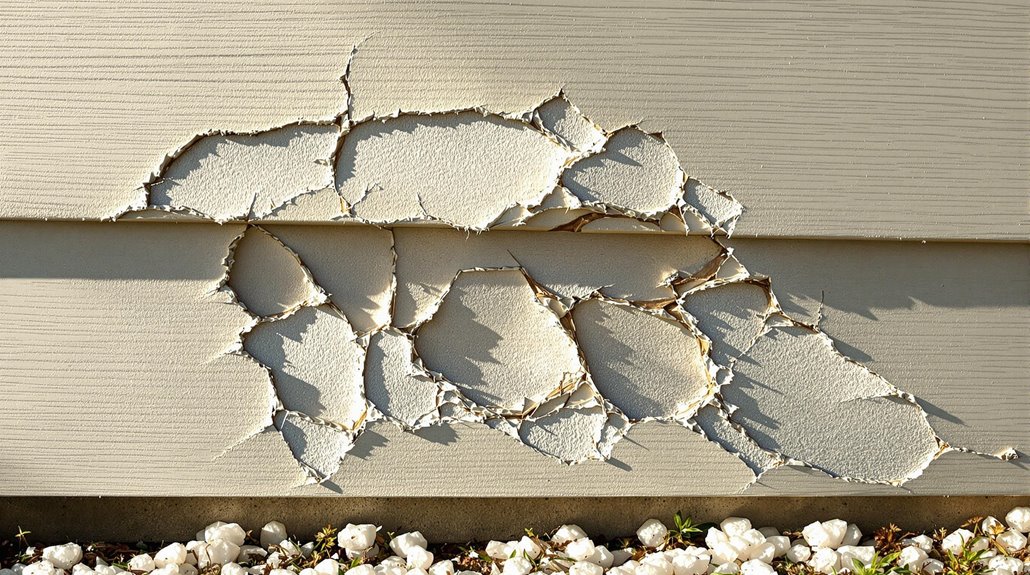
After identifying signs of hail damage, homeowners must take specific, calculated steps to address and repair their affected siding. The process begins with a thorough assessment of damage extent and siding material type, as different materials require specific repair techniques.
Homeowners should promptly contact their insurance provider and document all damage with detailed photos.
Selecting a qualified contractor is vital for proper repairs. Verification of credentials, experience, and reputation helps guarantee quality workmanship.
The chosen contractor should provide detailed quotes and demonstrate familiarity with insurance claim procedures.
Material selection should focus on quality products that match existing siding while potentially offering improved hail resistance.
Post-repair maintenance and warranty confirmation complete the essential repair process, helping to protect the home's structural integrity and appearance.
Working with a public insurance adjuster can increase settlement amounts by up to 800% compared to filing claims independently.
Breaking Down the Costs: Repair vs. Replacement
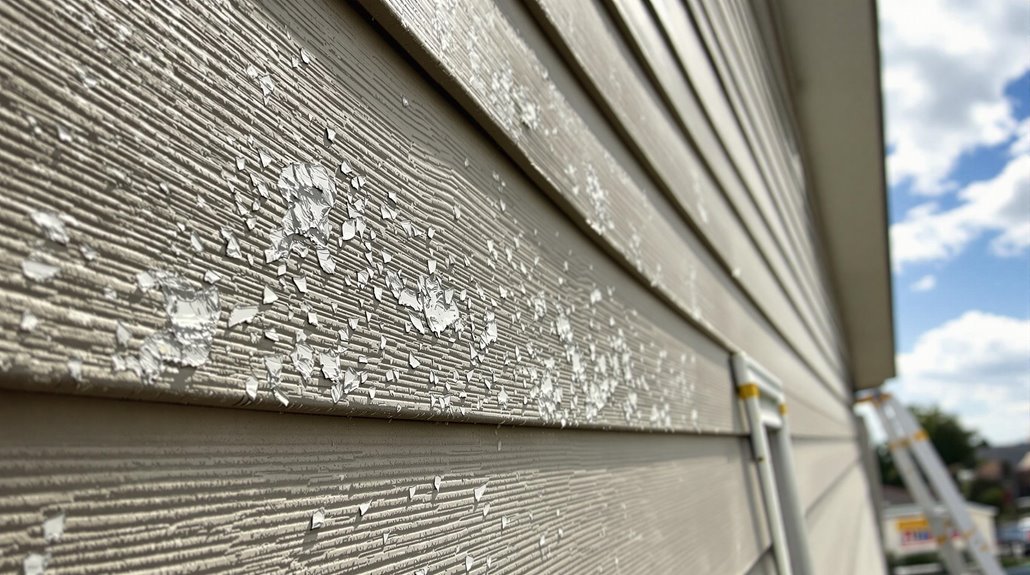
Homeowners facing hail-damaged siding must carefully weigh the financial implications of repairs versus full replacement. Minor hail damage repair costs typically range from $200 to $1,000, while extensive replacement offers long-term durability and potential energy efficiency benefits.
The decision between repair and replacement depends on several critical factors:
- Extent of damage and overall condition of existing siding, with extensive damage often making replacement more economically viable
- Insurance coverage parameters, which may influence the financial feasibility of either option
- Long-term value considerations, including energy savings and property value enhancement through replacement
The type of siding material greatly impacts both repair costs and replacement benefits.
While repairs present a lower initial investment, replacement can provide superior protection and reduced maintenance expenses over time, particularly when upgrading to more durable materials like fiber cement.
With average residential hail damage claims reaching approximately $12,000, homeowners should ensure their coverage limits adequately reflect potential repair costs.
How to Successfully File a Hail Damage Insurance Claim

A successful insurance claim for hail-damaged siding requires meticulous preparation and documentation from the outset. Essential claim filing tips include reviewing the insurance policy's coverage limits, conducting thorough inspections, and gathering extensive photographic evidence of the damage.
The process begins with promptly initiating the claim through available channels, whether online, mobile app, or phone. Insurance communication strategies should focus on providing detailed information about when and how the damage occurred.
Property owners should schedule an adjuster visit, collect multiple repair estimates, and maintain organized documentation throughout the process. If complications arise, consulting a public adjuster or legal counsel may be necessary.
Once approved, careful monitoring of repair work and retention of all claim-related documents guarantees proper resolution.
Most insurance companies require damage reporting within 60 to 90 days of discovery to maintain valid coverage eligibility.
Protecting Your Siding: Prevention and Maintenance Tips
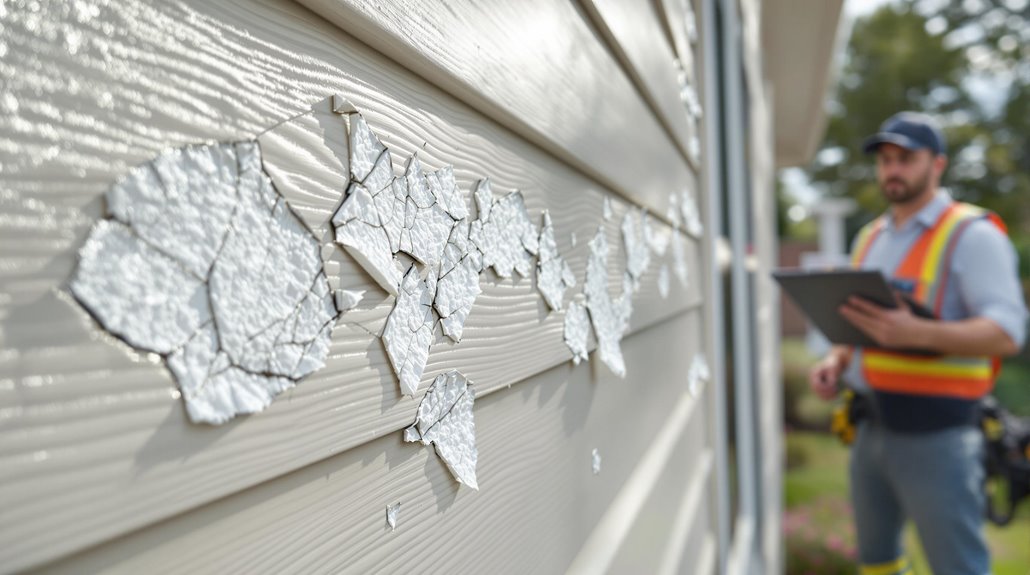
While protecting siding from hail damage requires thorough preventive measures, implementing a systematic maintenance routine greatly reduces vulnerability to storm-related deterioration.
Regular siding inspection and proactive maintenance help identify potential weaknesses before severe weather strikes. Homeowners should establish a detailed care schedule that includes cleaning, repairs, and preventive treatments.
- Conduct bi-annual inspections during ideal visibility conditions, checking for cracks, warping, or existing damage that could worsen during hail storms.
- Maintain proper drainage systems, including gutters and downspouts, to prevent water accumulation that weakens siding.
- Apply protective coatings appropriate for the siding material, and verify proper sealing around windows, doors, and joints.
This preventive approach, combined with prompt repairs and professional assessment when needed, greatly extends siding longevity and enhances storm resistance.
Consider hiring a public adjuster for expert guidance in documenting pre-existing conditions and maintaining detailed maintenance records that could strengthen future insurance claims.
The Benefits Of Consulting A Public Adjuster
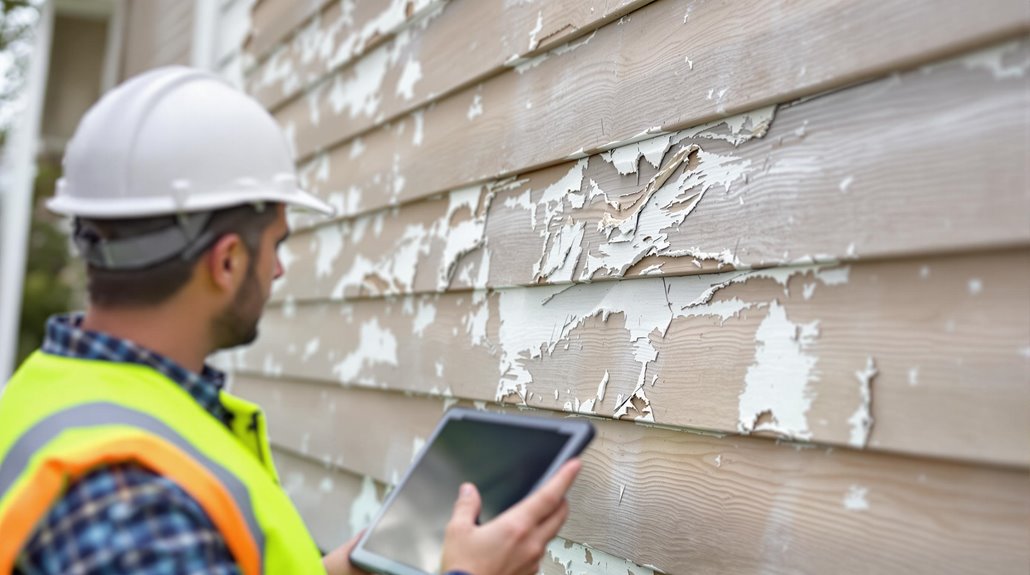
Public adjusters offer specialized expertise in maneuvering the complexities of hail damage insurance claims, providing unbiased assessments and extensive documentation to support homeowners' cases.
Their professional understanding of insurance policies, local building codes, and damage evaluation techniques helps streamline the claims process while ensuring all damage is properly identified and addressed.
Through skilled negotiation and thorough documentation, public adjusters often secure higher claim settlements by effectively challenging underestimations and advocating for complete restoration rather than partial repairs.
Working on a success fee basis of 10-20% commission, public adjusters have consistently helped property owners secure settlements up to eight times higher than self-filed claims.
Expertise In Insurance Claims
Steering through the complex world of insurance claims after hail damage requires specialized knowledge and expertise that many homeowners simply don't possess. Public adjusters bring invaluable insurance policy interpretation skills and claims process efficiency to the table, ensuring that policyholders receive maximum benefits under their coverage.
- Thorough understanding of policy terms, conditions, and legal requirements enables accurate claim assessment.
- Professional documentation management streamlines the claims process and prevents costly errors.
- Strategic negotiation capabilities help secure fair settlements from insurance companies.
These professionals navigate the intricate details of insurance claims while managing all necessary paperwork and communications. Their expertise not only reduces stress for homeowners but also typically results in higher settlement amounts compared to self-managed claims.
This makes their services particularly valuable for significant hail damage cases.
Public adjuster services can lead to substantially higher settlement amounts compared to working directly with insurance adjusters.
Objective Damage Assessment
A thorough assessment of hail damage requires an impartial, professional evaluation that examines both obvious and subtle forms of property deterioration. Public adjusters provide this essential service by conducting independent damage assessments that document all aspects of hail impact on siding and other exterior surfaces.
These professionals utilize extensive documentation methods, including detailed photographs and videos, to build compelling evidence for insurance claims. Their expertise in insurance negotiations proves invaluable when interpreting complex policy terms and advocating for fair settlements.
Public adjusters help homeowners avoid overlooked damage and unnecessary repair costs through their methodical inspection process. Their knowledge of policy requirements and industry standards guarantees that damage assessments accurately reflect the full scope of repairs needed, leading to more equitable claim resolutions.
Engaging a public adjuster typically results in higher settlement amounts compared to claims managed without professional assistance.
Streamlined Claim Process
Maneuvering the complexities of hail damage insurance claims becomes considerably more manageable when consulting a public adjuster. These professionals enhance claim efficiency through streamlined documentation management and thorough evidence collection, while implementing effective communication strategies with insurance providers.
- Public adjusters facilitate expedited claim processing by managing all correspondence with insurers and ensuring compliance with policy requirements.
- Their expertise in procedural matters and technical knowledge helps secure fair settlements that reflect the full extent of siding damage.
- Professional representation reduces stress for property owners while maximizing the likelihood of favorable claim outcomes.
Statistics show that homeowners who use public adjusters receive higher claim settlements, averaging $22,266 compared to $18,659 for those handling claims independently.
Public adjusters work on a commission basis, aligning their interests with those of policyholders, while providing valuable assistance in financial planning and cost-effective repair solutions throughout the claims process.
Higher Claim Payouts & Settlements
When seeking ideal compensation for siding hail damage, property owners who engage public adjusters consistently secure higher claim settlements compared to those who handle claims independently.
These professionals employ effective claim negotiation strategies, leveraging their expertise in damage assessment and policy interpretation to guarantee thorough coverage.
Public adjusters excel at maximizing insurance settlements through detailed documentation, precise cost estimation, and skilled negotiations with insurance companies.
Their commission-based fee structure aligns with the policyholder's interests, motivating them to secure best payouts.
Using advanced technology and thorough inspection methods, they identify both obvious and hidden damage that might otherwise go unnoticed.
Their pre-litigation expertise often resolves disputes efficiently, saving clients money while achieving favorable outcomes without the need for legal intervention.
The average homeowner receives $12,000 for claims related to hail damage when working with insurance companies.
About The Public Claims Adjusters Network (PCAN)
The Public Claims Adjusters Network (PCAN) represents a nationwide coalition of licensed insurance claim professionals who advocate for policyholders during the claims process.
These public claims specialists operate independently to guarantee fair settlements and thorough policy understanding for their clients.
Key adjuster roles within PCAN include:
- Conducting thorough damage assessments and policy reviews
- Preparing detailed documentation and evidence for claims
- Negotiating directly with insurance companies on behalf of policyholders
PCAN members work on a contingency fee basis, with rates regulated by state laws.
Their expertise extends across various regions, including international territories, providing essential support for complex insurance claims.
Through their specialized knowledge and dedication to policyholder advocacy, PCAN adjusters help streamline the claims process while maximizing settlement outcomes for property owners.
References
- https://bestexteriorsinc.com/blog/hail-damage-siding/
- https://www.insuranceclaimrecoverysupport.com/hail-and-wind-damage-insurance-claims/
- https://www.angi.com/articles/how-deal-siding-repair-after-storm.htm
- https://www.eagleview.com/construction/what-the-hail-part-2-repairing-hailstorm-damage/
- https://minnesotaexteriors.com/blog/hail-damage-siding/
- https://www.exploremanor.com/2023/07/13/tips-for-inspecting-hail-damaged-siding/
- https://es.lpcorp.com/blog/remodelers-how-to-recognize-the-signs-of-hail-damage
- https://www.lifetimequalityroofing.com/post/identifying-hail-damage-on-your-home-siding
- https://www.bmgexteriors.com/post/how-to-spot-hail-damage-on-your-roof-and-siding
- https://www.amosexteriors.com/blog/p.210324000/what-to-do-if-you-have-hail-damage-to-your-siding/
